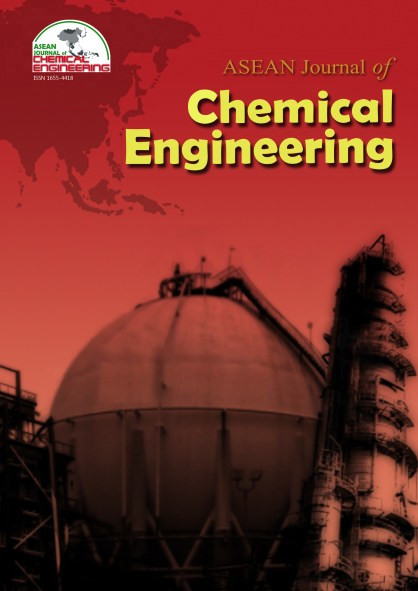Preliminary Study: Kinetics of Oil Extraction from Sandalwood by Microwave-assisted Hydrodistillation
Abstract
Sandalwood and its oil, is one of the oldest known perfume materials and has a long history (more than 4000 years) of use as mentioned in Sanskrit manuscripts. Sandalwood oil plays an important role as an export commodity in many countries and its widely used in the food, perfumery and pharmaceuticals industries. The aim of this study is to know and verify the kinetics and mechanism of microwave-assisted hydrodistillation of sandalwood based on a second-order model. In this study, microwave-assisted hydrodistillation is used to extract essential oils from sandalwood. The extraction was carried out in ten extraction cycles of 15 min to 2.5 hours. The initial extraction rate, the extraction capacity and the second-order extraction rate constant were calculated using the model. Kinetics of oil extraction from sandalwood by microwave-assisted hydrodistillation proved that the extraction process was based on the second-order extraction model as the experimentally done in three different steps. The initial extraction rate, h, was 0.0232 g L-1 min-1, the extraction capacity, CS, was 0.6015 g L-1, the second-order extraction rate constant, k, was 0.0642 L g-1 min-1 and coefficient of determination, R2, was 0.9597.References
2. Arctander, S., 1960. Sandalwood oil East India. Perfume and Flavor Materials of Natural Origin. Author, Elizabeth, NJ, pp. 574–576.
3. Bajgrowicz, J.A., Frater, G., 2000. Chiral recognition of sandalwood odorants. Enantiomer 5, 225–234.
4. Buchbauer, G., Sunara, A., Weiss- Greiler, P., Wolschann, P., 2001. Synthesis and olfactoric activity of side-chain modified beta-santalol analogues. European Journal of Medicinal Chemistry 36, 673–683.
5. Buchbauer, G., Winiwarter, S., Wolschann, P., 1992. Surface comparisons of some odour molecules: conformational calculations on sandalwood odour V. Journal of Computer-Aided Molecular Design 6, 583–592.
6. Buchbauer, G., Zechmeister-Machhart, F., Weiss-Greiler, P., Wolschann, P., 1997. Structure–activity relationships of sandalwood odorants: synthesis and odour of methyl-beta-santalol. Archives of Pharmacology (Weinheim) 330, 112–114.
7. Burdock, G.A., Carabin, I.G., 2008. Safety assessment of sandalwood oil (Santalum album L.). Food and Chemical Toxicology 46: 421-432.
8. Chemat F, Abert-Vian M, Zill-e-Huma Y-J (2009) Microwave assisted separations: green chemistry in action. In: Pearlman JT (ed) Green chemistry research trends. Nova Science Publishers, New York, pp 33–62.
9. Chinese Pharmacopoeia Committee, 2010. Chinese Pharmacopoeia, 9th edition. China Medical Science and Technology Press, Beijing, China, Appendix 62.
10. Choi, W.-K., Park, B.-S., Lee, Y.-H., Jang, D.Y., Yoon, H.Y., Lee, S.-E., 2006. Fumigant toxicities of essential oils and monoterpenes against Lycoriella mali adults. Crop Protection 25, 398–401.
11. Hettiarachchi, D.S., Gamage, M., Subasinghe, U., 2010. Oil content analysis of sandalwood: A novel approach for core sample analysis. Sandalwood Research Newsletter 25: 1-4.
12. Ho Y.S., Oumarou H.A.H., Fauduet H., and Porte C. 2005. Kinetics and model building of leaching of water-soluble compounds of Tilia sapwood. Separation and Purification Technology, Vol. 45, pp. 169-173.
13. Imdorf, A., Bogdanov, S., Ibanez, O.R., Calderone, N.W., Spivak, M.P., 1999. Use of essential oils for the control of Varroa jacobsoni Oud in honey bee colonies; special issue – dynamics and control of varroa parasitism on apis. Apidologie 30, 209–228.
14. Marongiu B., Piras A., Porcedda S, Tuveri E. (2006) "Extraction of Santalum album and Boswellia carterii Birdw. volatile oil by supercritical carbon dioxide: influence of some process parameters." Flavor and Fragrance Journal 21(4): 718 – 724.
15. Meizane S. and Kadi H. 2008. Kinetics and thermodynamics of oil extraction from olive cake. Journal of the American Oil Chemist’s Society, Vol. 85, pp. 391-396.
16. Moretta P., Ghisalbert E.L., Piggott M.J, Trengove R.D. (1998) “Extraction of oil from Santalum spicatum by supercritical fluid extraction.” ACIAR Proceedings Series 84: 83-85.
17. Opdyke, D.L.J., 1974. Reviews on fragrance raw materials. Sandalwood oil, East Indian. Food and Cosmetics Toxicology 12 (Supp.), 989–990.
18. Pande, M.C., 1977. Medicinal oils and their importance. Medicine and Surgery 17, 13–16.
19. PDR Herbal, 2004. Sandalwood. Santalum album. PDR for Herbal Medicine, third ed. Medical Economics Company, Montvale, NJ, pp. 702–703.
20. Rabesiaka L.R., Havet J., Porte C., and Fauduet H. 2007. Solid–liquid extraction of protopine from Fumaria officinalis L.-Analysis determination, kinetic reaction and model building. Separation and Purification Technology, Vol. 54, pp. 253-261.
21. Shvets, N.M., Dimoglo, A.S., 1998. Structure–odour relationships: results of an applied electron-topological approach. Nahrung 42, 364–370.
22. Uhm J.T. and Yoon W.B. 2011. Effects of high-pressure process on kinetics of leaching oil from soybean powder using hexane in batch systems. Journal of Food Science, Vol. 76, pp. 444-449.
23. Raynie DE (2000) Extraction. In: Wilson ID, Adlard ER, Cooke M, Poolie CF (eds) Encyclopedia of separation science. Academic Press, San Diego.
Copyright holder for articles is ASEAN Journal of Chemical Engineering. Articles published in ASEAN J. Chem. Eng. are distributed under a Creative Commons Attribution-NonCommercial 4.0 International (CC BY-NC 4.0) license.
Authors agree to transfer all copyright rights in and to the above work to the ASEAN Journal of Chemical Engineering Editorial Board so that the Editorial Board shall have the right to publish the work for non-profit use in any media or form. In return, authors retain: (1) all proprietary rights other than copyright; (2) re-use of all or part of the above paper in their other work; (3) right to reproduce or authorize others to reproduce the above paper for authors’ personal use or for company use if the source and the journal copyright notice is indicated, and if the reproduction is not made for the purpose of sale.



